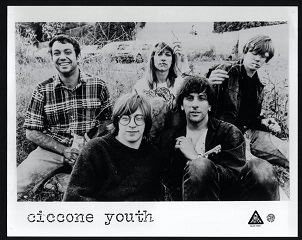
Though promo photos would suggest that Ciccone Youth were essentially Sonic Youth plus Mike Watt, he's not technically heard on the original Ciccone Youth recordings. "Tuff Titty Rap" and "Into The Groove(y)" (their cover of Madonna's "Into The Groove") were recorded during the March 1986 EVOL sessions at Martin Bisi's studio. These two tracks would be Sonic Youth's contribution to the first Ciccone Youth single, with Mike Watt doing a version of Madonna's "Burnin' Up" on the flipside, assisted by Ethan James and Greg Ginn. While he may not have played on their Madonna cover, Watt did contribute to two other Sonic Youth tracks during the March '86 sessions - his first recordings since the accidental death of Minutemen bandmate D. Boon in December 1985, following a Sonic Youth show in California.
One of the tracks that Watt lent his bass wizardry to was a sculptured soundpiece whose guitar parts were mostly long pick scrapes and droning open strings, possibly modeling the car crash sounds of Lee's poem/lyric (depending on whether it was written prior to the recording). This piece, "In The Kingdom #19", would end up as the fourth track on EVOL, making it the first guest appearance on a Sonic Youth album since Lydia Lunch on "Death Valley '69". The other tune had "B-side" written all over it, a version of Kim Fowley's "Bubblegum" that was recorded in the same fashion as many of the band's other covers - they put the original version on two tracks and played along to it, ultimately removing it from the final mix (or in the case of "Into the Groovey", feeding the original into the mix at key intervals). In many ways, I would also consider this collaboration with Mike Watt as a Ciccone Youth project, but it was instead released as the bonus track of the cassette and CD versions of EVOL as well as the b-side to Starpower.

The band found themselves in another experimental identity crisis towards the end of the Sister sessions circa March/April 1987. It started with Lee feeding loops from a KISS tape into Steve's headphones, who was drumming along accordingly. This served as the foundation for what would become "Master-Dik". Though the KISS clips are worked into the mix, the song is largely based around unique parts played by (presumably) Lee on electric guitar and Kim on bass, with guest lead guitarist J Mascis, whose band Dinosaur (Jr) had already shared many stages with Sonic Youth. Thurston laid down a pretty sick rap overtop, improvised to some degree and impressive either way! There are also a couple of odd samples, and of course a drum machine track that serves as the foundation for a whole other mix - the "non-beatbox" version was originally a bonus track on the CD (but not the cassette) of Sister in June 1987, the beatbox version appeared as the A-side of a 12" single/EP released in early '88. Despite both versions appearing under the Sonic Youth name, Thurston's cries of "We're Ciccone!" and the use of his "Royal Tuff Titty" moniker strongly suggests that this track has the spirit of Ciccone, if not the name.
Based on writings in Lee's JRNLS80s, the remix was done at Martin Bisi's studio in late May. The remix was often played after Sonic Youth's set on the June '87 European tour. Also recorded at Martin's was "this beat box mix of Thurston scratching a hendrix record along to a drum track", which Lee began incorporating into his late May '87 From Here To Infinity sets with Steve. A spoken piece he would read during these gigs, "Me and Jill", would later be merged with the "Doriella du Fontaine" reconstruction (aka "Hendrix Cosby") as a single track on the Ciccone Youth album (now with Steve reading the text).
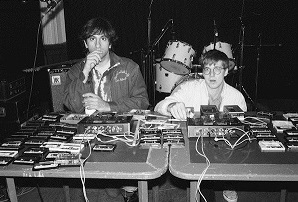
I think this recording session must be referring to their cover of "Within You Without You", which is credited in the Daydream Nation deluxe liners as "recorded by John Loder at Southern Studio London 1988". The year must be an error, as I can't think of anything else they'd have cut in London, and it aligns with the reveal of the Beatles tribute a month earlier. It also reveals the original title of the Ciccone Youth full-length project: Valentine's. Keep in mind that the Master-Dik EP wasn't out yet, and Daydream Nation hadn't even been written (or planned?), but they were already all in on the Ciccone record by mid '87.
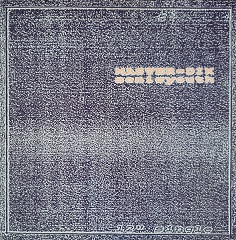
I think the Master-Dik EP was intended for release by the end of '87, but eager fans would have to wait until January 1988 to be perplexed by a weird rap song, a Ramones cover, and a bunch of sound effects. That's a very simplified assassination of the 12", which I actually do find to be an interesting project, but I don't think it was received that well at the time. The remix of the title track is awesome, the studio version of "Beat on the Brat" calls back the October encores, and the collage of wonder is curious, at least. It begins with excerpts from a June 18th, 1987 Geneva, Switzerland radio show - I assume the same studio they visited in 1983 which is responsible for much of Sonic Death? - a performance that was notoriously acknowledged as lousy in various tour journals. You only get a glimpse on the EP, most of which is Thurston goofin' on their oddball drum/voice version of "Ticket To Ride", which segues into the only other version of "Master-Dik" aka Thurston reciting parts of the first and last verse over a drum/bass/keyboard melee. I do think it would be interesting to hear the entire session - they stuck "Stereo Sanctity" on a Mix Tape - but that seems unlikely (and I'd still petition for the '83 set first!).
After the final North American Sister tour was over, the band directed their focus to the Ciccone Youth project. They recorded at Wharton Tiers' studio from November 1987 through January 1988 ("Beat on the Brat" likely dates from these sessions, but I won't pretend to call it Ciccone). The February 1988 issue of The Catalogue indicates that the original release date was February but that the band was still in the studio and March '88 seemed more likely. By now, The Whitey Album title is already in place, though it's described as "latest working title, after 'Valentine'." The "Whitey" Album title is a callback to the band's threat to record the Beatles' entire White Album, which attained a slightly mythic status in the mid-80s. Keep in mind that Master-Dik had just been released, which would have served as a precursor to the full-blown Ciccone Youth album if it had dropped immediately after.
Also noted in the Catalogue piece are a few tracks that appear on a tape of assorted mixes they'd received to review, including "Swamp" (supposedly reminiscent of Can, "whose mesmerising repetition is invoked [...] before a premature end disrupted by cut-up noise" - perhaps "Third Fig"?) and four mixes of "Making the Nature Scene" "each dub heavier, harder, sparser and with more noisy interference than the last". Their take on Robert Palmer's "Addicted to Love" is also on the tape, and Kim relates its origin story ("With that, I went into a band-booth, where you record your voice over a backing-track and leave with an acetate of the song. We liked it so much, I went to the company and bought the backing tape. There are 3 versions now, but we can't decide which is cheesiest.") Imagine all the material for a deluxe Whitey if dubs still exist...
Perhaps the most curious inclusion is a version of "European Son", a Velvet Underground song "which degenerates into a dramatic mess of sound FX massed over looped bass and rhythm". That's definitely not on The Whitey Album, but it was released on The End Of Music (As We Know It), a 1988 compilation cassette. Except it was credited solely to Thurston Moore (from Sonic Youth), and specifically states "Thurston Moore: All instruments". Huh! I assume it's the same version as the description of the "dramatic mess of sound FX" certainly applies, so perhaps it's something he cooked up on his own during the Ciccone sessions (or it was just included on the tape given to The Catalogue cuz it was something new and cool).
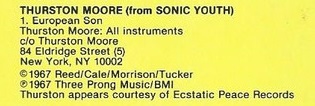
As you probably know, The Whitey Album didn't come out in March 1988. Indeed, it didn't come out in 1988 at all - the band debuted a set of brand new material in June and was already in the studio capturing those tunes by summer, with the results dropping as Daydream Nation later in the year. It was decided that a goofy side project, however serious the efforts had been, might take a back seat to the proper Sonic Youth double album. Flash forward to September 1988, and although Sonic Youth have an album coming out the following month, it's Ciccone Youth who get the interview in NME, and a weird one it is. This oddball piece finds Jack Barron interacting with the four members of Ciccone Youth via TV screen, using the alter egos they'd later print in the liners of The Whitey Album. Lee is "The Sigh", Kim is "Fly-Fly Away" (no hyphen in the liners), and Steve is "SS Beats Control" (just "Beat" in the liners). Thurston's previously established "Royal Tuff Titty" identity gets a specific title: "King Poopy D The Royal Tuff Titty". It's an extremely entertaining read, though I'm not entirely sure whether it's a creative writing exercise masquerading as a review, or a goofy interview with some embellishment. Perhaps a bit of both?
Some curiosity amongst the chaos:
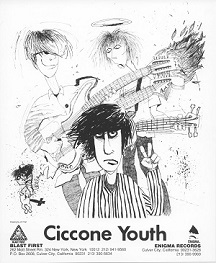
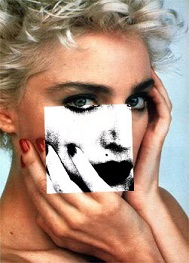
January 21st, 1989. Sonic Youth are in the middle of their first Australian tour supporting Daydream Nation, but the cover of SOUNDS magazine is all about Ciccone - The Whitey Album was finally out and the band is interviewed in detail (but not in character) about the ideas behind many of the tracks on the album (Steve re: the aforementioned "Hendrix Cosby": "The Hendrix thing is blatantly stolen off this record of popular Hendrix stuff done by Bill Laswell. Thurston thinks it sounds like the theme tune from The Cosby Show.") As with any Youth interview, it can take some effort to separate the joke answers from the real info, but it's still entertaining.
I'm sure I'll have more to say about The Whitey Album at another time (not that sure, I suppose, hence all of this), but I think it's essential to consider the placement of "Master=Dik" within the Ciccone window and how it really does exist between two worlds. Perhaps if The Whitey Album had come out first, "Master-Dik" would have been released under the Ciccone Youth brand. (As a side note: The Whitey Album was indeed mastered at Masterdisk!)
If you stack both mixes of "Master-Dik", they more or less run in time with each other - there's a couple of moments in the remix that drop a beat but if that's accounted for, it's easy to follow the thread of the song between the two versions. I encourage you to take a "deep headphones listen" to both if you never have, and follow along with the detailed song chart below. Before that, here's a quick bullet point reference for all of the tracks in the song and some of the mix differences:
"MASTER-DIK"
LAYOUT
INTRO - A - B - C - A - D - E - A - B - F
KIM
EADG
CENTER
THURSTON
RAP
CENTER
LEE
EADGBE
LEFT
J MASCIS
EADGBE
EVERYWHERE
INTRO 00:00-00:16
The song begins with a loop that I am pretty sure is sampled from Lee's guitar at the
end of "Stereo Sanctity". He was using a Kapa Continental for GDD# at this point, which
produced very hot sounds when picked behind the bridge. Combined with its whammy bar,
Lee put both tricks to good use on "Stereo Sanctity" and "Cotton Crown". Since "Master-Dik"
was recorded during the sessions for SISTER, it makes sense that they sampled their own
sounds as a foundation.
A beat enters 12 seconds in on both versions - live drums on the SISTER take, and
electronic hi-hats on the SINGLE. On the SISTER version, you can also hear stray
sounds from the bass that were mixed out of the SINGLE.
A SECTION 00:16-00:31
The "Stereo Sanctity" loop continues, and the SINGLE version drops a pretty heavy
electronic drum beat at 23 seconds.
Thurston's verse:
One two, one two, one two titty
I know every nook and cranny in New York City
We're Ciccone and that's enough
I'm the Royal Tuff Titty and you gotta taste my love
On the SINGLE version, Lee is silent. On the SISTER version, Lee plays:
E--------------------------------
B--------------------------------
G--------------------------------
D--------------------------------
A-----4----4----4----4-----------
E---3----3----3----3---3\5-5/3---
Kim does not play on either version.
J Mascis can be heard making fuzz/wah noise in the SISTER version.
B SECTION 00:32-01:02
On both versions, this is where the bass and J Mascis properly enter. On the SISTER
version Lee is playing chords, which I don't think are in the mix on the SINGLE.
I think the "Stereo Sanctity" loop drops out on the SINGLE but stays on SISTER,
and I'm pretty sure I also hear a very buried KISS tape in the SISTER mix starting
at 00:45 or so.
Thurston:
Taste my love...yeah...
Come on everybody and rock with me
I am the one on the Christmas tree
Now whippin' out the words like a moving story
Now walkin' up the stairs and corkin' up the board
Trippin' everywhere, I don't fuckin' care
Put on some dark eyes and wave me goodbye
Lee:
E------------
B---8---5----
G---8---6---- listen for the strumming pattern // keep playing the A chord
D---8---7----
A---6---7----
E-------5----
Kim:
G------------------------------
D---1-1-1----------------------
A---------0--0-0-0-0-0-0-0-0---
E------------------------------
J Mascis plays w/ heavy wah and fuzz:
E-------------------------------------------------------------------------------------
B-------------------------------------------------------------------------------------
G---------7-7-7-9~~9br-9^10^9^10^9^10^9^10^9^10^9^10^9^10-9^10^9-11br-9^10^9-12br~~~--
D---7~~~~~----------------------------------------------------------------------------
A-------------------------------------------------------------------------------------
E-------------------------------------------------------------------------------------
E---------------------------------------------------------------12-15-12-12-12-15-12-12-12-15-12-12-12---
B-----------------------------13b~~~---12~-12-13-12~~-12-13-12-------------------------------------------
G---12br~~--------------12-14----------------------------------------------------------------------------
D---------10/9-10-12-14----------------------------------------------------------------------------------
A--------------------------------------------------------------------------------------------------------
E--------------------------------------------------------------------------------------------------------
This will get you to about 48 seconds in, but to be honest I don't intend on tabbing every note of
J's heavily improvised, wah-and-whammy modulated sonic offering. He stays within that range of notes
for much of it. Everything here is just an approximation.
C SECTION 01:03-01:42
On the SISTER version, the "Stereo Sanctity" loop, guitar, and bass all drop out at the
start of this section. On the SINGLE version, there's an actual pause in the beat where
Thurston screams and the song resumes. On the SINGLE, the "Stereo Sanctity" loop does
not stop until 1:20, when Lee's guitar comes in playing an arpeggiated riff that is not
present on the SISTER mix.
At this point, the first KISS tape is heard. It's a portion of "Strutter" from the KISS ALIVE
album, taken from the chorus ("Everybody says she's looking good" - the underlined part
is the loop). It is pitched slightly lower. On the SISTER version it plays for the duration
of this section, on the SINGLE it stops almost 15 seconds earlier at 01:28. At that point,
it's just Thurston and the beat until the "Stereo Sanctity" loop starts up again at 01:35.
Thurston riffs over the KISS loop - "yo!" "woo!" "ciccone!" etc
On the SISTER version, you can hear J Mascis come back in around 01:12, and his guitar
is panned back and forth. The "Stereo Sanctity" loop returns around 01:38. I don't think the
bass is in the mix at this point, but you can play a low E along with the KISS loop.
Lee plays this arpeggiated figure at 1:20 on the SINGLE version. It sounds like he's kind of bending
the strings a bit, or there's a chorus or something.
E---------------------------------------------------
B--------------------(14)--------------------(10)--- notes on B string optional
G---------14-14-------14\---------10-10-------10\---
D---14-14-------14-14-------10-10-------10-10-------
A---------------------------------------------------
E---------------------------------------------------
A SECTION 01:42-01:51
This is a transitional section between the two KISS loops. The SISTER mix is fairly
simple, the live drums keep going with J's wah guitar, the "Stereo Sanctity" loop,
and Thurston riffin' on the mic. Lee and Kim are not heard.
In the SISTER mix, Thurston says something indecipherable, sniffles and coughs. He isn't heard
in the SINGLE mix.
The SINGLE mix takes a different approach, with the beat dropping out completely and a
bizarre sample of Conky the Robot from Pee-Wee's Playhouse saying "R-r-ready to assist you, Pee-Wee!".
The beat comes back after this.
D SECTION 01:51-02:25
This is when the second KISS tape is used. It's another bit from "Strutter", the
first two words of the song: "I know a thing or two about her". In both versions,
the "Stereo Sanctity" loop stops at the beginning of this section. In the SINGLE mix,
the loop does not come back for the rest of the song.
Lee and Kim also drop out, but in the SISTER mix, the bass comes back at 2:07, playing a G to B
figure that isn't present in the SINGLE mix. J Mascis plays wanky trash throughout both.
Thurston chants "I know!" along with Paul Stanley and then declares something like
"Gene Simmons is an ugly mother..." before trailing off and muttering something indecipherable.
Then it's back to "I know!" and "We're Ciccone!".
Once again, the KISS tape is out about 15 seconds earlier in the SINGLE mix, 02:18
compared to the SISTER version where it leaves at 02:33.
On the SISTER version, the bass enters early during this part, at 2:07 -
G-----------------------------------
D-----------------------------------
A----------------------------------- x 4
E---3-3-3-3-3-3-3-3-3-3-3-3\7-7-7---
Then she just hangs on the low G until dropping to the F - this is where her part is
brought into the mix on the SINGLE version, tab continued in the next section.
Around 2:10, J starts playing a figure like this, with heavy wah and some pinch harmonics:
E------------------------------------
B------------------------------------
G---14~15~--14~15~--14~15~14~--------
D----------------------------15~-----
A-------------------------------15~--
E------------------------------------
After a few times:
E----------------------------------
B----------------------------------
G------14------14-15-16-17-18-19/-- play the last bit w/ almost a staccato trem pick (!)
D---15----15-----------------------
A----------------------------------
E----------------------------------
E SECTION 02:25-03:25
In the SISTER mix, Thurston can be heard muttering various whatevers. Then he
delivers a few perplexing lines that aren't entirely clear to me, but sound something like:
Got off balance, it's genocide and Sun Ra on crack man you're gonna wish ... [??? trails off...]
Like a hylozoic got a pan-psych throat saying "all is one and one is two too many"
Sss.ss..sspeed up. Yeah. AAAAHHHHHOOOOOOOO!
Could also be "gentle cycle", was there a washing machine at Sear Sound? The SINGLE mix omits the start
of this part, cutting in at "crack man you're gonna...".
Lee goes back and forth between A and F - this isn't the clearest tab, just listen for the rhythm
and when he accents the high strings.
E------------1-1-1-------------5------1-1-1-------------5------1-1-1-------------5-------------------
B--------1---1-1-1-1\5-5-5--5--5--1---1-1-1-1\5-5-5--5--5--1---1-1-1-1\5-5-5--5--5--1----------------
G---6-6--2---2-2-2-2\6-6-6--6--6--2---2-2-2-2\6-6-6--6--6--2---2-2-2-2\6-6-6--6--6--2---2--2-2-2-2---
D---7-7--3---3-3-3-3\7-7-7--7--7--3---3-3-3-3\7-7-7--7--7--3---3-3-3-3\7-7-7--7--7--3---3--3-3-3-3---
A---7-7--3---3-3-3-3\7-7-7--7--7--3---3-3-3-3\7-7-7--7--7--3---3-3-3-3\7-7-7--7--7--3---3--3-3-3-3---
E---5-5--1---1-1-1-1\5-5-5--5--5--1---1-1-1-1\5-5-5--5--5--1---1-1-1-1\5-5-5--5--5--1---1--1-1-1-1---
At 2:42, just stick on that last F chord w/ varying palm mute
At 3:08 he changes to:
E-----------
B---1---2---
G---2---2--- x 6
D---3---2--- you could also slide up to the A barre chord like before
A---3---0---
E---1-------
Kim sort of follows Lee's chords, but at times delays landing on the same note as him.
G----------------------------------------------------------------------------------
D----------------------------------------------------------------------------------
A----------------------------------------------------------------------------------
E---1--1-1-\5-5-5--5-5-5-5-5--1-1-1-1-1-1--1-1-\5-5-5--5-5-5-5-5---1-1-1-1-1-1-1---
Around 2:42, hold F:
G-----------------------------
D-----------------------------
A-----------------------------
E---1-1-1-1-1-1-1-1-1-1-1-1--- etc etc
In the SINGLE mix, the bass drops out when the KISS loop returns around 3:08 but it
cuts abruptly back to the bass playing F before going back into the next verse.
In the SISTER mix, she keeps on the F but might be doing some scrapy/slidy picking too.
J continues w/ heavy wah + fuzz:
E---------------------------------------------------------------------------
B---------------------------------------------------------------------------
G---------------------------------------------------------------------------
D---7~~~--7\9-10-9---10-9-10-9^10^9------10-------------------12-13br~13~~~-
A-----------------------------------10------10\12~~--12-12-15---------------
E---------------------------------------------------------------------------
E--------------------------------------------------------------------------------------------------------
B--------------------------------------------------------------------------------------------------------
G--------------------------------------------------------------------------------------------------------
D---12--11-12-11-12-11-12-11-14~~~~--14-15-14~--------------------------------------10/9~~~--10-9-10-9~~~
A-----------------------------------------------15-15-14^15^14--14-14-12-10-12~~~12----------------------
E--------------------------------------------------------------------------------------------------------
When everyone starts sticking on F, J goes into deep whammy bar wah storm shred mode. On the SISTER
version, J can be heard playing straight through, but in the SINGLE mix he drops out when the KISS
loop starts up again, which doesn't happen in the SISTER mix.
The tail end of his shred that they did mix into the SINGLE version is something like this:
E---------------------------------------------12br~~~~~--12-12-15^12-12--12-12-15^12-12--12-15-17~~~~~--
B---12-12-12-13-12-13-12-13-12--------------------------------------------------------------------------
G------------------------------14-12-14-12-12-----------------------------------------------------------
D-------------------------------------------------------------------------------------------------------
A-------------------------------------------------------------------------------------------------------
E-------------------------------------------------------------------------------------------------------
In the SISTER mix, the "Stereo Sanctity" loop returns at 2:46 and plays until the end of the song.
A SECTION 03:25-03:41
Thurston:
London fuck you're pissing me off
Hollywood weirdo, cough cough cough
Won't you please let me rock you
Now I'm just a boy and not much to do
On both versions, Lee plays:
E--------------------------------
B--------------------------------
G--------------------------------
D--------------------------------
A-----4----4----4----4-----------
E---3----3----3----3---3\5-5/3---
It sounds like the bass is droning A but very cloud-like in the mix and probably not necessary:
G-------
D-------
A---0---
E-------
J Mascis continues noisily improvising around the same basic themes.
B SECTION 03:41-04:17
Thurston:
Everybody says "doesn't come from above"
You're gonna scream when you taste my love
Taste my love
Yeah.....C-C-C-C-Ciccone...C-C-C-C-Ciccone..
Yeah we're Ciccone...
...aaaaaaaaahhhhh........
Lee:
E------------
B---8---5----
G---8---6---- this time keep strumming while running the A chord up the fretboard
D---8---7----
A---6---7----
E-------5----
Kim:
G------------------------------
D---1-1-1---------------------- x 9
A---------0--0-0-0-0-0-0-0-0---
E------------------------------
J Mascis continues noisily improvising around the same basic themes.
F SECTION 04:17-05:11
The song abruptly cuts to a guitar playing F# to E, with the E chord banged out
continuously as the song fades. I'm not sure if this is a sample from something,
or something they played themselves - any ideas? I've heard Mellencamp's name thrown
around...
In addition to this, one of Lee's many bell tapes can be heard chiming away while
Thurston babbles about how Ciccone they are. On the SISTER mix you can hear
faint bursts of the "Stereo Sanctity" loop, which pauses only for that F#-E bash.
Thurston:
We're ciccone...ciccone..c-ciccone..ciccone
text + tab by Chris Lawrence
Return to the Sonic Youth Guitar/Bass Tab Archive